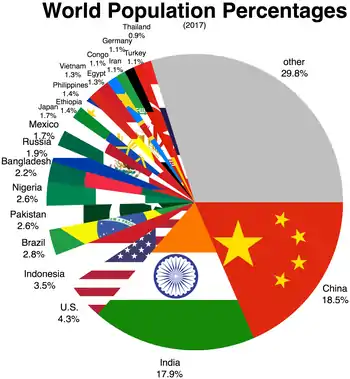ကမ္ဘာ့လူဦးရေ
ကမ္ဘာ့လူဦးရေ ဆိုသည်မှာ လက်ရှိအသက်ရှင်လျက်ရှိသော လူသား စုစုပေါင်းဦးရေဖြစ်သည်။ ၂၀၁၇ ဧပြီလ ၂၄ တွင် ကမ္ဘာ့လူဦးရေသည် ခန့်မှန်းခြေ ၇,၅၀၀,၀၀၀,၀၀၀ ရောက်ရှိခဲ့ပြီဖြစ်သည်။[1] ကုလသမဂ္ဂမှ ကြိုတင်ခန့်မှန်းထားသည်မှာ ကမ္ဘာ့လူဦးရေသည် ၂၁၀၀ ခုနှစ်တွင် ၁၁.၂ ဘီလီယံ တိုးပွားလာမည်ဟုဆိုသည်။[2]



ကမ္ဘာ့လူဦးရေသည် ၁၃၁၅-၁၇ ငတ်မွတ်ခေါင်းပါးမှုကြီးနှင့် ၁၃၅၀ သေမင်းတမန်ကပ်ဆိုး ပြီးကတည်းက ဆက်တိုက်တိုးပွားလာခဲ့သည်။ ယင်းအချိန်က ၃၇၀ မီလီယံခန့်သာ ရှိခဲ့သည်။[3] တစ်နှစ်လျင် ၁.၈% အထက်သို့ တိုးပွားလာသော အမြင့်ဆုံး ကမ္ဘာ့လူဦးရေ တိုးပွားနှုန်းသည် ၁၉၅၅-၁၉၇၅ ခုနှစ်တွင် ဖြစ်ပွားခဲ့သည်။ ၁၉၈၀ ခုနှစ်များနှောင်းပိုင်း၌ နှစ်စဉ်မွေးဖွားနှုန်းသည် ၁၃၉ မီလီယံခန့်ဖြင့် အမြင့်ဆုံးဖြစ်ခဲ့သည်။[4] ယခုအခါမူ ၁၃၅ မီလီယံ ပုံသေနှုန်းထားဟု ဆိုသည်။[5] နှစ်စဉ် သေဆုံးနှုန်းသည် ၅၆ မီလီယံရှိပြီး ၂၀၄၀ ခုနှစ်တွင် ၈၀ မီလီယံနှုန်း ရှိလိမ့်မည်ဟု မျော်လင့်ရသည်။[6] ကုလသမဂ္ဂ လူဦးရေ ထောက်ပံ့ရေး၏အဆိုအရ ၂၀၁၁ အောက်တိုဘာ ၃၁ တွင် ၇ ဘီလီယံသို့ ရောက်ရှိခဲ့သည်။[7][8][9]အမေရိကန် သန်ခေါင်စာရင်းဌာနအရမူ ၂၀၁၂ မတ်လ ၁၂ တွင် ဖြစ်သည်။[10]
၂၀၁၆ ခုနှစ်အရ ကမ္ဘာ့လူဦးရေ၏ ပျမ်းမျှအသက်သည် ၃၀.၁ နှစ်ဖြစ်ပြီး အမျိုးသား ၂၉.၄ နှင့် အမျိုးသမီးမှာ ၃၀.၉ နှစ်ဖြစ်သည်။[11] ၂၀၁၂ ကုလသမဂ္ဂ၏ မျော်မှန်းချက်များအရ ကမ္ဘာ့လူဦးရေသည် ပုံမှန်တိုးတက်ဖွယ်ရှိပြီး ၂၀၅၀ ခုနှစ်တွင် ၈.၃ ဘီလီယံမှ ၁၀.၉ ဘီလီယံကြား ရောက်လိမ့်မည်ဟုဆိုသည်။[12][13] ၂၀၀၃ UN Population Division အရမူ ကမ္ဘာ့လူဦးရေသည် ၂၁၅၀ ခုနှစ်တွင် ၂၄ ၈ ဘီလီယံရှိလာမည်ဟုဆိုပြီး[14] ၂၀၁၄ ခန့်မှန်းချက်အရ ၉.၃ နှင့် ၁၂.၆ ဘီလီယံဟု ကြိုတင်ခန့်မှန်းထားသည်။[15][16] အချို့သော သုံးသပ်သူများက လူသားများ သဘာဝပတ်ဝန်းကျင်အပေါ် ရိုက်ခတ်မှု၊ ကမ္ဘာလုံးဆိုင်ရာ အစာပင်ရင်းနှင့် စွမ်းအင်အရင်အမြစ်များအပေါ် လွန်ကဲစွာ သုံးစွဲမှု စသည်တို့ကြောင့် ကမ္ဘာ့လူဦးရေသည် ရေရှည်တွင် ကြာရှည်ခံ/မခံ ဆိုသည်အား မေးခွန်းထုတ်ကြသည်။[17][18][19] ခန့်မှန်းချက်အရ အသက်ရှင်ခဲ့ဖူးသမျှ လူသားဦးရေ စုစုပေါင်းသည် ၁၀၆ မှ ၁၀၈ ဘီလီယံကြား ရှိသည်ဟုဆိုသည်။[20][21][22]
| World population (millions, UN estimates)[23] | ||||
|---|---|---|---|---|
| # | Top ten most populous countries | 2000 | 2015 | 2030* |
| 1 | 1,270 | 1,376 | 1,416 | |
| 2 | 1,053 | 1,311 | 1,528 | |
| 3 | 283 | 322 | 356 | |
| 4 | 212 | 258 | 295 | |
| 5 | 176 | 208 | 229 | |
| 6 | 138 | 189 | 245 | |
| 7 | 123 | 182 | 263 | |
| 8 | 131 | 161 | 186 | |
| 9 | 146 | 143 | 139 | |
| 10 | 103 | 127 | 148 | |
| World total | 6,127 | 7,349 | 8,501 | |
Notes:
| ||||
ကိုးကား
- World Population Clock: 7.5 Billion People (2017) - Worldometers (in en)။
- World Population Prospects - Population Division - United Nations။
- Jean-Noël Biraben (1980), "An Essay Concerning Mankind's Evolution". Population, Selected Papers. Vol. 4. pp. 1–13. Original paper in French: (b) Jean-Noël Biraben (1979)."Essai sur l'évolution du nombre des hommes". Population. Vol. 34 (no. 1). pp. 13–25.
- World Population Prospects, 2012 revision (697 million births from 1985–1990)။ United Nations (2012)။ August 27, 2014 တွင် မူရင်းအား မော်ကွန်းတင်ပြီး။ May 11, 2015 တွင် ပြန်စစ်ပြီး။
- Annual number of births – World။ United Nations Population Division (2011)။ March 27, 2015 တွင် ပြန်စစ်ပြီး။
- World Population estimates by the US Census Bureau။ USCB။ May 22, 2012 တွင် ပြန်စစ်ပြီး။
- "Population seven billion: UN sets out challenges"၊ BBC News၊ October 26, 2011။ October 27, 2011 တွင် ပြန်စစ်ပြီး။
- Coleman၊ Jasmine။ "World's 'seven billionth baby' is born"၊ The Guardian၊ October 31, 2011။ October 31, 2011 တွင် ပြန်စစ်ပြီး။
- 7 billion people is a 'serious challenge။ UPI (October 31, 2011)။ November 9, 2011 တွင် ပြန်စစ်ပြီး။
- The World Population at 7 Billion။ Random Samplings, official blog of the U.S. Census Bureau (October 31, 2011)။ 26 February 2017 တွင် မူရင်းအား မော်ကွန်းတင်ပြီး။ October 23, 2016 တွင် ပြန်စစ်ပြီး။
- CIA, The World Factbook: Field Listing: Median Age။
- World Population Prospects, the 2012 Revision – "Low variant" and "High variant" values။ UN (2012)။ June 15, 2013 တွင် ပြန်စစ်ပြီး။
- World population projected to reach 9.6 billion by 2050 – UN report။ UN News Centre (June 14, 2013)။ June 16, 2013 တွင် ပြန်စစ်ပြီး။
- "Key Findings"။ Long-Range Population Projections (PDF)။ Proceedings of the United Nations Technical Working Group on Long-Range Population Projections။ New York: United Nations: Department of Economic and Social Affairs။ 2003။ July 3, 2010 တွင် ပြန်စစ်ပြီး။
- Carrington, Damien (September 18, 2014)။ World population to hit 11bn in 2100 – with 70% chance of continuous rise။ The Guardian။ September 21, 2014 တွင် ပြန်စစ်ပြီး။
- "World population stabilization unlikely this century" (September 14, 2014). Science 346 (6206): 234–7. AAAS. doi:. ISSN 1095-9203. PMID 25301627. PMC:4230924. Retrieved on September 21, 2014.
- Peter P. Rogers; Kazi F. Jalal & John A. Boyd (2008)။ An Introduction To Sustainable Development။ Earthscan via Google Books။ p. 53။ Cite uses deprecated parameter
|last-author-amp=(အကူအညီ) - "Overpopulation's Real Victim Will Be the Environment"၊ TIME၊ October 26, 2011။ February 18, 2013 တွင် ပြန်စစ်ပြီး။
- Zehner၊ Ozzie (2012)။ Green Illusions။ Lincoln and London: University of Nebraska Press။ pp. 187–331။
- Fact or Fiction။
- World Population Prospects: The 2015 Revision။ UN Population Division။ December 22, 2015 တွင် မူရင်းအား မော်ကွန်းတင်ပြီး။. Linked to at Download Files, where it states that the figures are for July 1 of the given year.
